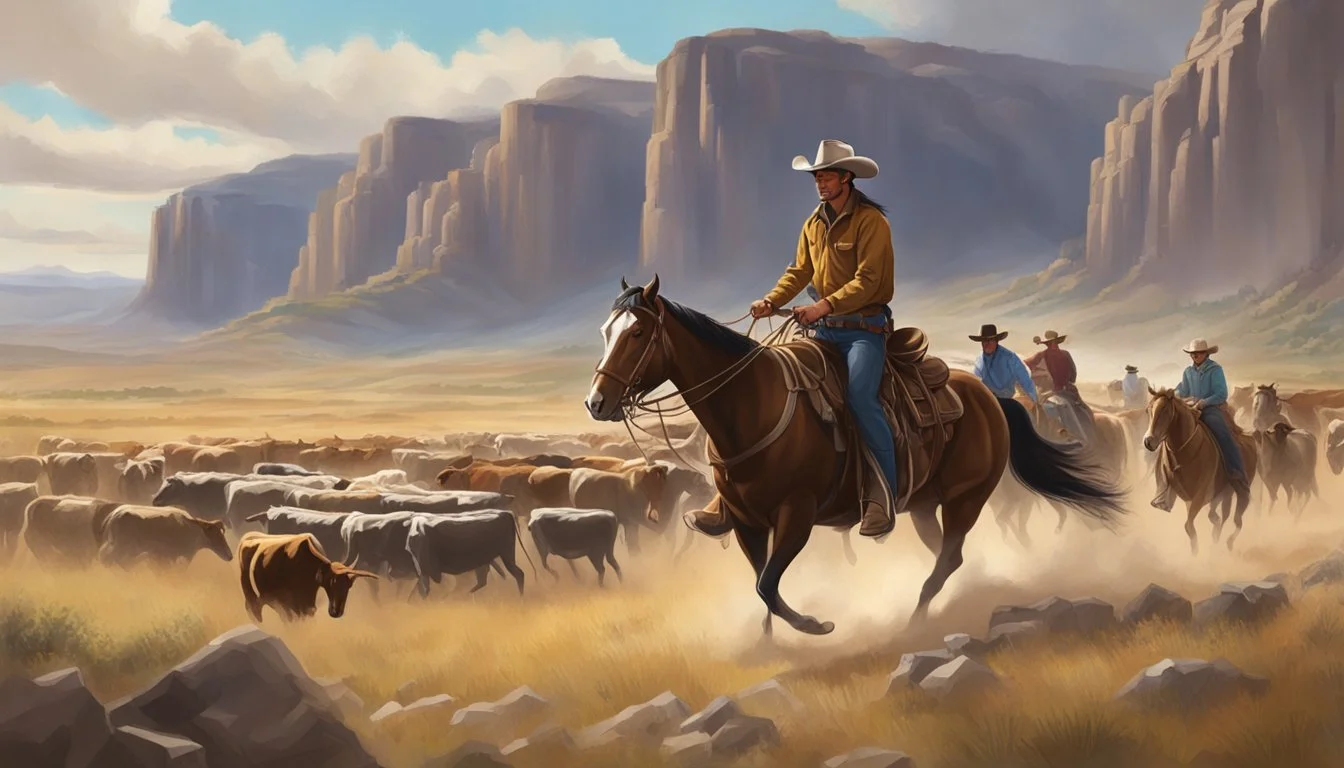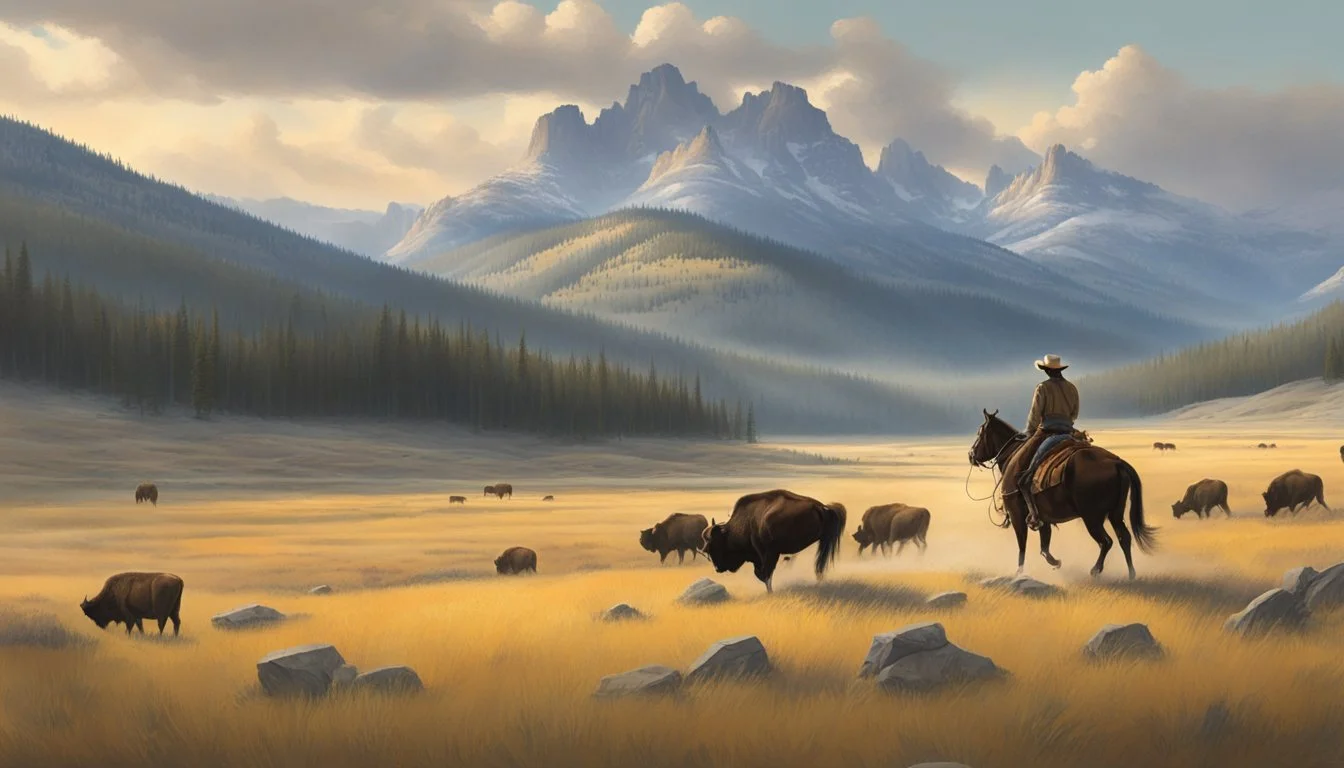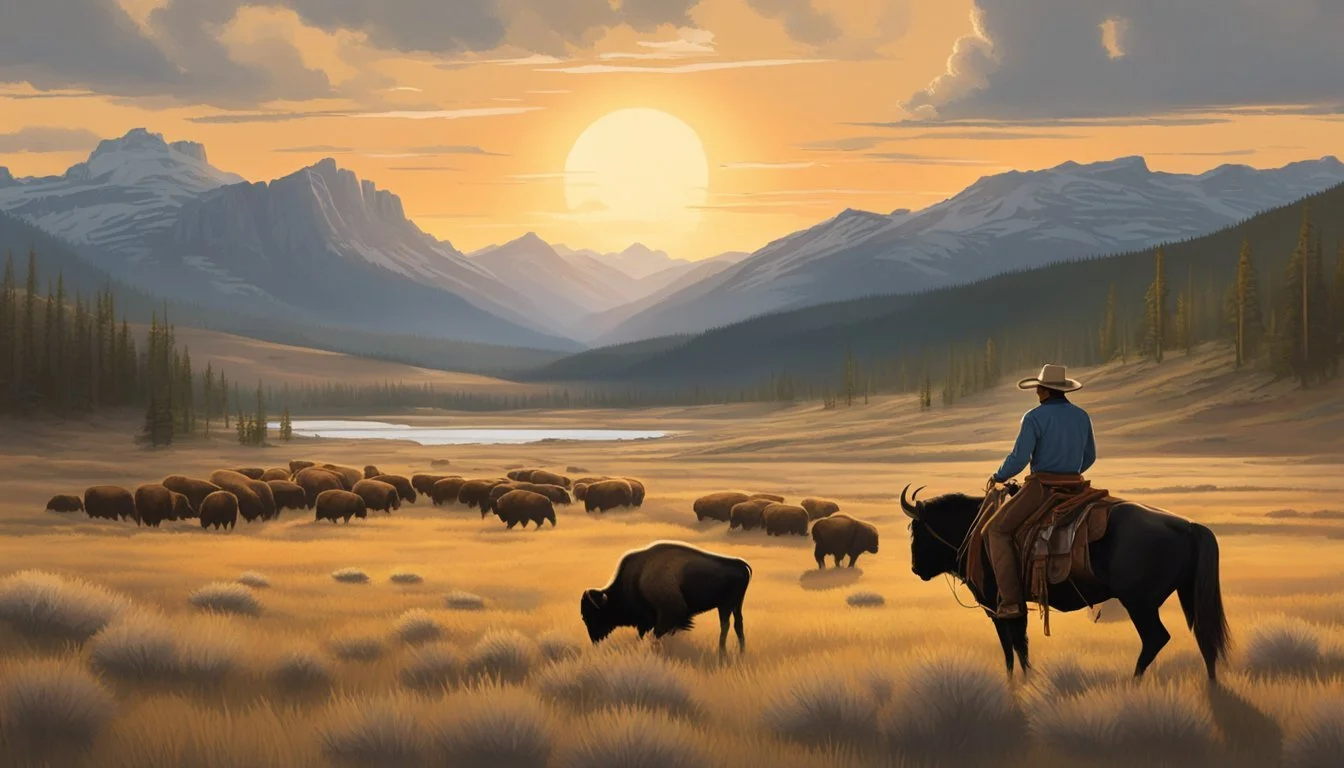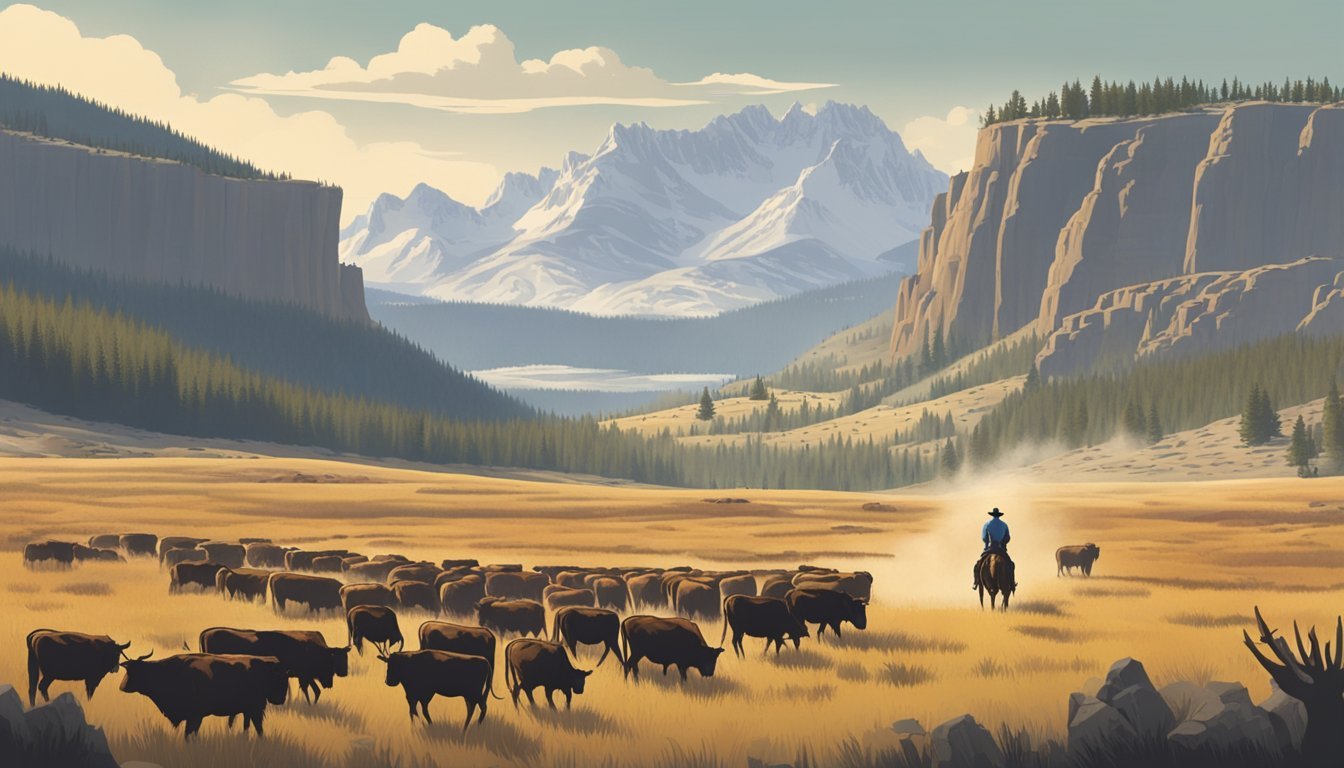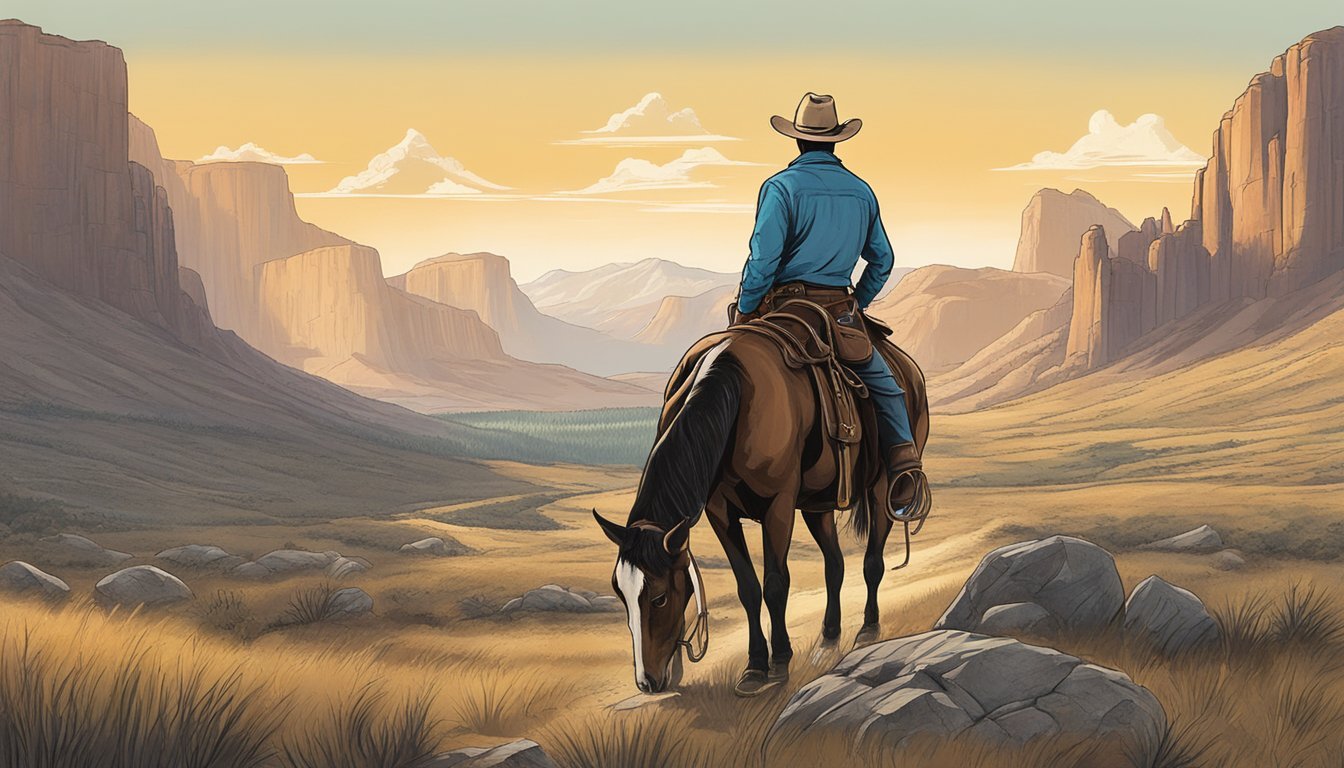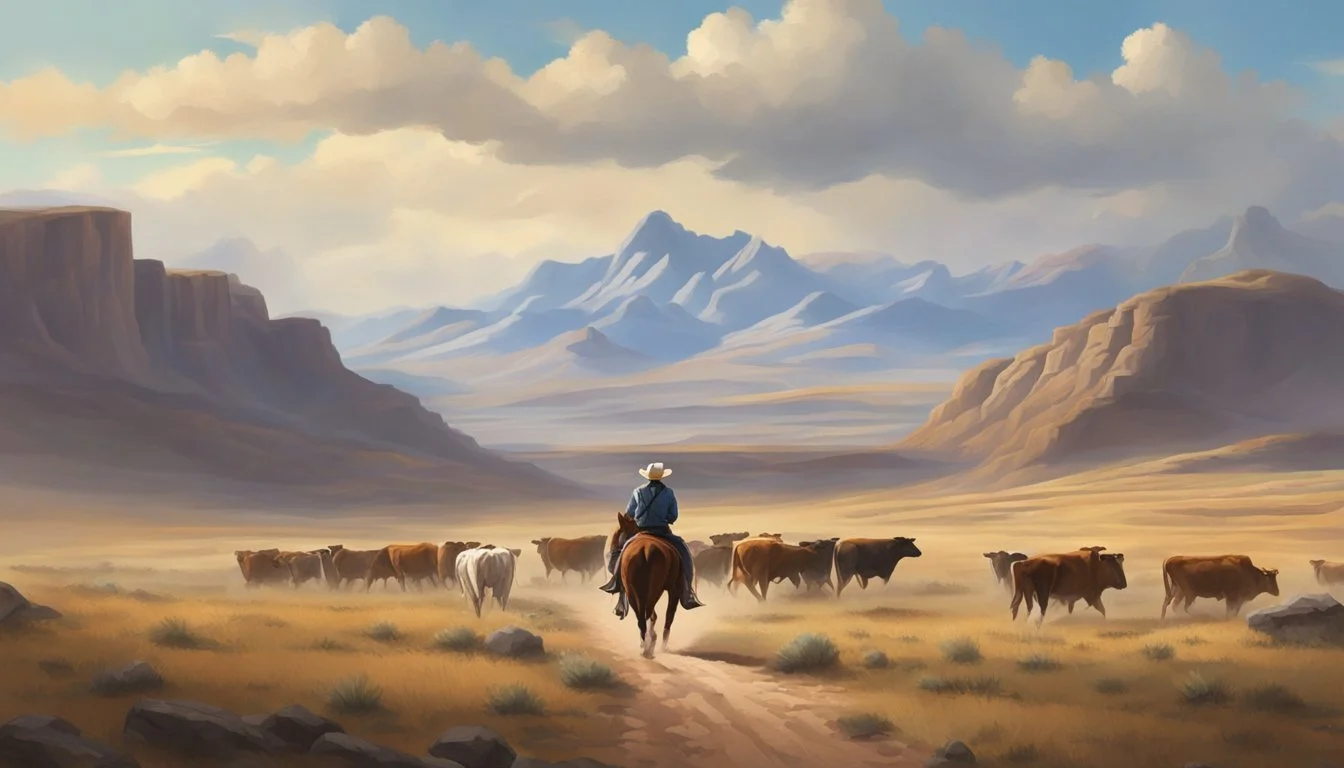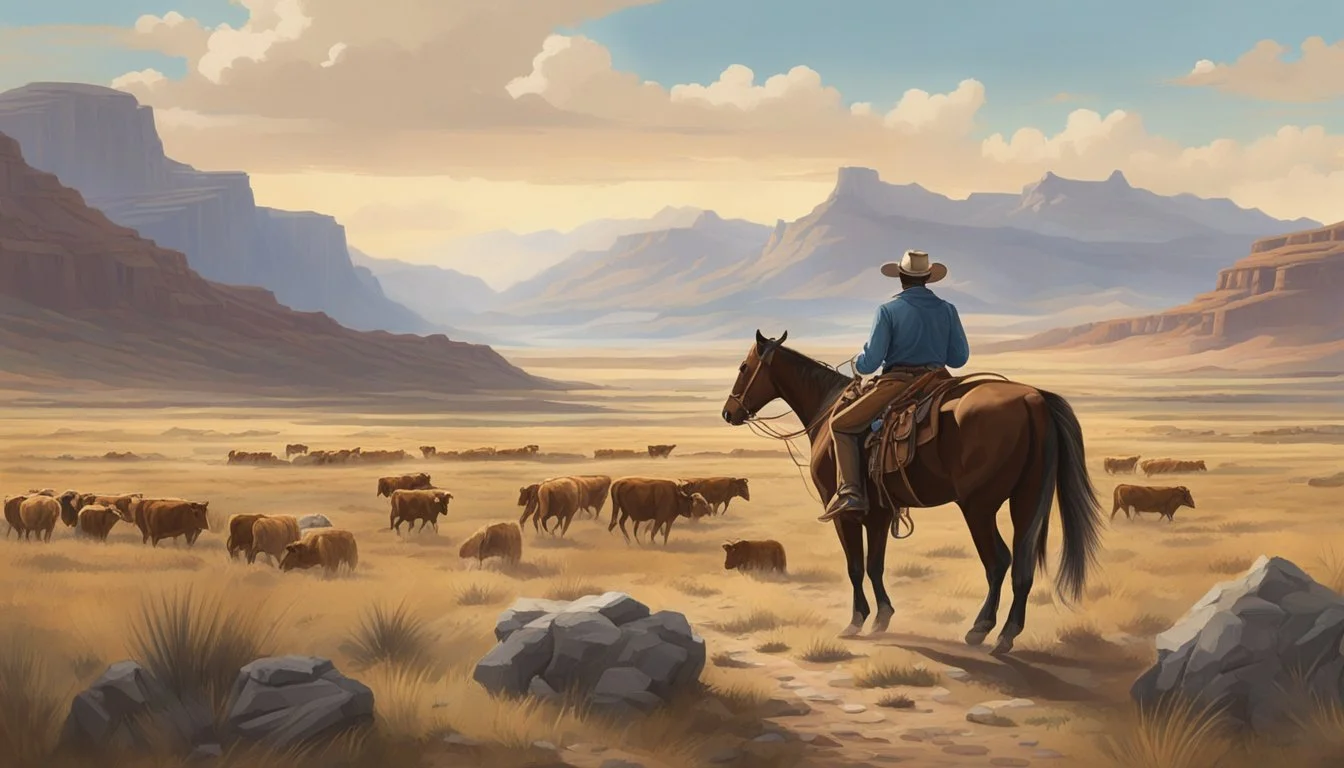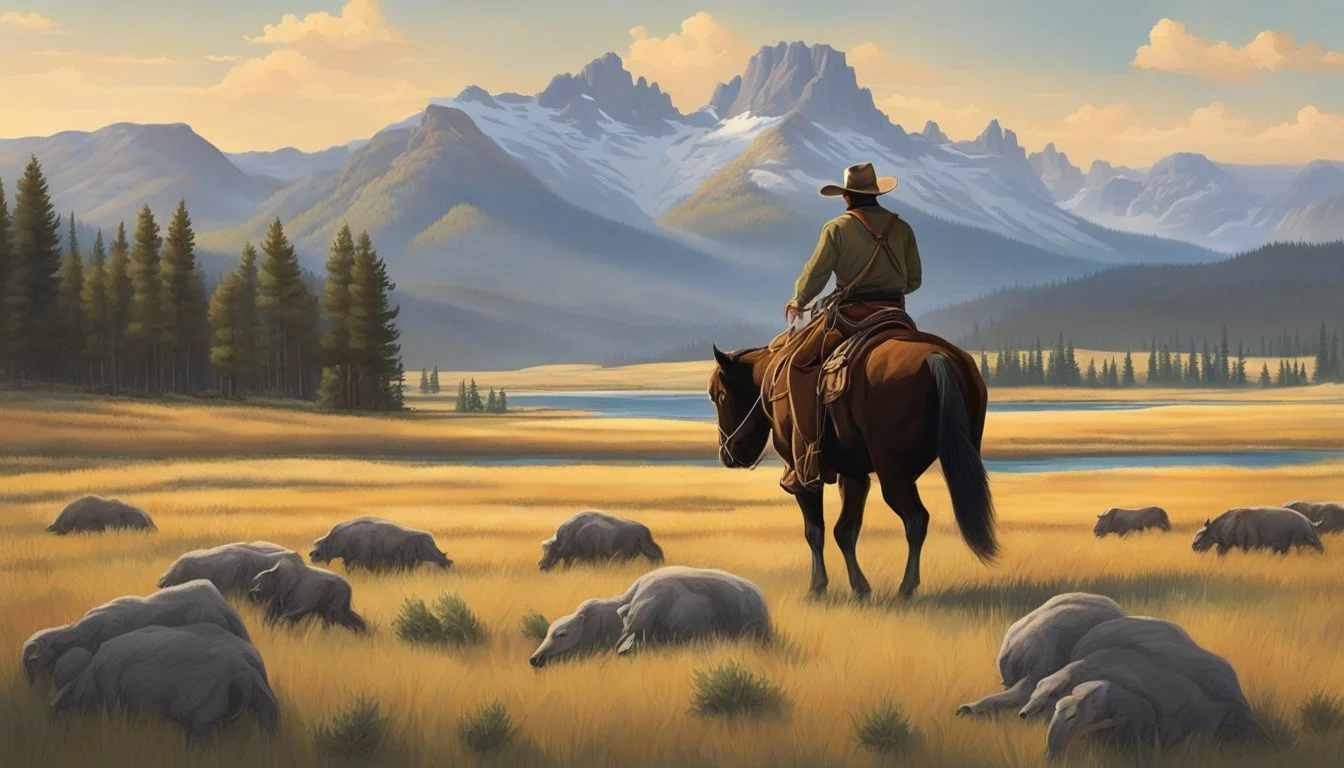The Cowboy Way of Life: Yellowstone's Authentic Depiction Brings Ranch Reality to Television
Yellowstone captivates audiences with its gritty portrayal of modern ranching life. The show's creators and cast have gone to great lengths to ensure authenticity in their depiction of cowboys and ranch culture. Yellowstone's commitment to realism stems from the involvement of real cowboys who bring their expertise to the set, teaching actors the nuances of ranch life and horsemanship.
Taylor Sheridan, the show's creator, draws from his own experiences and connections to the cowboy world. His affiliation with the 6666 Ranch adds credibility to the series, infusing it with genuine cowboy culture. The show's attention to detail extends beyond just the characters, encompassing the rugged Montana landscape and the day-to-day operations of a working ranch.
While Yellowstone presents a dramatized version of ranch life, it touches on real issues facing modern cowboys. The series explores themes of land preservation, family legacy, and the clash between traditional values and modern pressures. This blend of authenticity and compelling storytelling has resonated with viewers, offering a window into a way of life that is both romanticized and threatened in today's rapidly changing world.
Historical Roots and Inspirations
Yellowstone draws from rich historical traditions and cultural legacies of the American West. The series weaves together elements from different eras to create a compelling narrative that resonates with viewers.
Evolution of the Cowboy Culture
The cowboy culture depicted in Yellowstone has deep roots in American history. It emerged in the mid-19th century as cattle ranching expanded across the western frontier. Cowboys developed unique skills, traditions, and a code of ethics that shaped their identity.
Over time, the cowboy way of life adapted to changing economic and technological landscapes. Ranchers faced new challenges as the open range gave way to fenced properties and industrialization. Despite these shifts, core values like hard work, self-reliance, and respect for the land endured.
Yellowstone captures this evolution, showing modern cowboys balancing traditional practices with contemporary realities. The series highlights the ongoing struggle to preserve ranching heritage in the face of development and changing social norms.
Influence of 1883 and 1923 on Yellowstone
The prequels 1883 and 1923 provide crucial historical context for Yellowstone. These series explore the Dutton family's early days in Montana, offering insight into the foundation of their ranch and values.
1883 portrays the perilous journey westward, showcasing the grit and determination of pioneers. It establishes the Duttons' connection to the land and their commitment to building a legacy.
1923 bridges the gap between the frontier era and modern times. It depicts the challenges faced by ranchers during Prohibition and the Great Depression. This series illustrates how the Dutton family's resilience and adaptability set the stage for their present-day influence in Yellowstone.
Together, these prequels enrich the main series by tracing the evolution of ranching culture and the Dutton dynasty across generations.
The World of Yellowstone
Yellowstone immerses viewers in a rugged Montana landscape where the Dutton family fights to protect their ancestral ranch. The show's cinematic visuals and complex characters bring the modern West to life.
Plot Synopsis and Dutton Family Saga
The series centers on the Dutton family, led by patriarch John Dutton. They own the largest contiguous ranch in the United States, constantly under threat from land developers, a nearby Indian reservation, and America's first national park.
John's children play crucial roles. Beth, his fierce and loyal daughter, handles the family's business dealings. Kayce, a former Navy SEAL, struggles to balance family life with ranch responsibilities.
As external forces pressure the Duttons to sell their land, internal family conflicts add to the drama. Each season brings new challenges, from political maneuvering to violent confrontations with rivals.
Cinematic Landscape of Montana
Montana's breathtaking scenery serves as more than just a backdrop in Yellowstone. The show's creators use the state's vast prairies, towering mountains, and pristine rivers to emphasize the characters' connection to the land.
Sweeping aerial shots showcase the expansive Yellowstone Ranch, highlighting its value and vulnerability. The changing seasons reflect the story's tone, from sun-drenched summer pastures to harsh winter landscapes.
Filming locations include real Montana ranches and towns, adding authenticity to the show's depiction of rural life. This attention to visual detail helps transport viewers into the world of modern-day cowboys and ranchers.
Character Studies and Performances
Yellowstone's success stems largely from its complex, multi-dimensional characters brought to life by talented actors. The show's protagonists embody the spirit of the modern West while grappling with personal and professional challenges.
John Dutton's Leadership and Legacy
Kevin Costner portrays John Dutton, the patriarch of the Dutton family and owner of the largest contiguous ranch in the United States. Costner's performance captures John's unwavering determination to protect his land and legacy. The character embodies traditional cowboy values while navigating the complexities of modern politics and business.
John's leadership style is both authoritative and nurturing. He makes tough decisions to ensure the ranch's survival, often at great personal cost. His relationship with his children is central to the show's narrative, highlighting the importance of family in ranching culture.
Costner's nuanced portrayal brings depth to John's internal struggles, particularly as he faces threats to his way of life and contemplates his legacy.
Beth Dutton's Resilience and Complexity
Kelly Reilly breathes life into Beth Dutton, John's fiercely intelligent and ruthless daughter. Beth's character challenges stereotypes about women in the West, showcasing her as a formidable businesswoman and strategist.
Reilly's performance explores Beth's vulnerability beneath her tough exterior. The character's traumatic past and complex relationships, especially with Rip Wheeler, add layers to her personality. Beth's loyalty to her father and the ranch is unwavering, often leading her to make morally ambiguous choices.
Her sharp wit and take-no-prisoners attitude make her a fan favorite. Reilly's portrayal balances Beth's strength with moments of raw emotion, creating a compelling and relatable character.
Rip Wheeler: The Loyal Ranch Hand
Cole Hauser's portrayal of Rip Wheeler has become iconic in the world of Yellowstone. Rip embodies the modern cowboy - tough, skilled, and fiercely loyal to the Dutton family. Hauser's performance captures Rip's stoic nature and deep-seated devotion to John Dutton and the ranch.
Rip's relationship with Beth adds a romantic element to the show, showcasing a softer side to his character. His role as the ranch's enforcer puts him in morally gray situations, which Hauser portrays with nuance and depth.
The character's backstory as an orphan taken in by John Dutton adds complexity to his motivations and actions. Hauser's chemistry with the cast, particularly with Reilly and Costner, enhances the show's emotional core.
Ranching Life Depicted in Yellowstone
Yellowstone offers a nuanced portrayal of modern ranching, balancing authentic elements with dramatized storylines. The show captures many realities of ranch work while taking some creative liberties for entertainment value.
Everyday Realities of Contemporary Ranching
Yellowstone showcases the daily challenges faced by ranchers. Cattle management, land maintenance, and financial pressures are accurately depicted. The show highlights the struggle to keep large ranches operational in the face of economic and environmental challenges.
Ranch owners in Yellowstone grapple with issues like water rights and land development. These conflicts mirror real-world concerns for many Western ranchers today. The series also portrays the seasonal nature of ranch work, from calving in spring to hay harvesting in summer.
Family dynamics play a central role, reflecting the multigenerational nature of many ranching operations. The Dutton family's dedication to preserving their legacy resonates with real ranching families striving to maintain their way of life.
Portrayal of Ranch Hands and Rodeo
Yellowstone's depiction of ranch hands offers insight into the cowboy lifestyle. The bunkhouse scenes showcase the camaraderie and hardships of these workers. Ranch hands are shown performing various tasks, from mending fences to branding cattle.
The show features rodeo events, a significant part of Western culture. Bull riding and bronc riding scenes capture the excitement and danger of these competitions. Yellowstone highlights how rodeo skills often translate to practical ranch work.
Ranch hands in the series display a mix of traditional cowboy values and modern attitudes. This blend reflects the evolving nature of ranch work in the 21st century. The show also touches on the seasonal and migratory nature of some ranch hand jobs.
Authentic Representation of Ranch Work
Yellowstone's attention to detail in portraying ranch work adds authenticity to the series. Scenes of cattle drives, horse training, and equipment maintenance are largely accurate. The show consulted with real ranchers to ensure proper techniques and terminology are used.
The physical demands of ranching are not glossed over. Characters are shown performing hard labor in various weather conditions. This realistic depiction underscores the grit required in the ranching profession.
Yellowstone also addresses modern aspects of ranch management. Use of helicopters for herding and GPS tracking for cattle reflect current practices. The series balances traditional methods with newer technologies, mirroring the reality of contemporary ranching.
Taylor Sheridan's Artistry
Taylor Sheridan's talent shines through his masterful direction and compelling storytelling. His skill in casting and character development brings authenticity to the screen.
Direction and Storytelling Prowess
Sheridan's directorial style captures the essence of the American West. He skillfully blends sweeping landscapes with intimate character moments, creating a visual feast for viewers.
His storytelling techniques keep audiences engaged, weaving complex narratives that explore themes of family, loyalty, and power struggles. Sheridan's writing often draws from his personal experiences, lending a genuine feel to the dialogue and situations.
The pacing of his stories builds tension effectively, with unexpected twists that keep viewers on the edge of their seats. His ability to balance multiple storylines showcases his expertise in crafting intricate plots.
Casting and Character Development
Sheridan's eye for talent has led to exceptional casting choices. He selects actors who embody their characters' spirits, bringing depth and nuance to their roles.
The characters in Sheridan's productions are multi-dimensional, with complex motivations and flaws. This realism resonates with audiences, making the characters relatable and memorable.
Sheridan works closely with his cast, guiding them to deliver powerful performances. His collaborative approach allows actors to fully inhabit their roles, resulting in authentic portrayals.
The character arcs in Sheridan's works are carefully crafted, showing growth and change over time. This attention to detail creates a rich, evolving narrative that keeps viewers invested in the characters' journeys.
Cowboy Iconography and Fashion
Cowboy culture has left an indelible mark on American fashion and popular imagery. The iconic look of the Western cowboy continues to influence style and resonate with people across the globe.
Western Wear and Cowboy Aesthetics
The cowboy uniform is instantly recognizable. Denim jeans, often in a boot cut style, form the foundation. Paired with a button-up shirt, typically plaid or solid-colored, they create a rugged yet practical ensemble.
Cowboy boots are a crucial element. Made of leather with pointed toes and high heels, they serve both form and function. The classic cowboy hat, wide-brimmed and made of felt or straw, completes the look.
Accessories like bandanas, belt buckles, and bolo ties add personal flair. Leather vests and chaps provide additional protection for working cowboys.
Western wear has evolved beyond its utilitarian roots. High-end designers now incorporate cowboy-inspired elements into their collections. This blend of tradition and contemporary style keeps cowboy fashion relevant in modern culture.
Cultural Impact and Industry Influence
Yellowstone has transformed the modern Western genre and expanded into a multimedia franchise. Its authentic portrayal of ranch life resonates with viewers while inspiring new content.
Yellowstone's Influence on Modern Western Genre
Yellowstone revitalized interest in Western-themed entertainment. The show's gritty realism and complex characters redefined expectations for the genre. Its popularity led to a surge in Western-inspired fashion and lifestyle trends.
Paramount capitalized on this cultural shift, investing in more Western content. The series sparked conversations about land rights, Native American relations, and rural economic challenges. Its success encouraged other networks and streaming platforms to develop similar shows.
Yellowstone's impact extends beyond entertainment, influencing public perception of ranching and cowboy culture. The series highlighted the modern cowboy's struggles and triumphs, bringing renewed attention to agricultural heritage.
Spinoffs and the Expansion of the Yellowstone Universe
Paramount+ leveraged Yellowstone's success by creating multiple spinoffs. These new series explore different time periods and locations within the Yellowstone universe. "1883" delves into the Dutton family's origins, while "1923" focuses on an earlier generation.
The spinoffs maintain the franchise's commitment to authenticity. They feature detailed historical settings and tackle themes relevant to each era. This expansion allows for deeper exploration of American Western history and culture.
These new shows attract both existing fans and new viewers to the franchise. They contribute to a growing ecosystem of content that spans television, streaming, and potentially other media formats.
Authenticity vs. Hollywood
Yellowstone strives to balance authentic Western elements with dramatic storytelling. The show employs various techniques to create a believable ranching world while still delivering compelling entertainment.
Real Locations and Set Design
Yellowstone films on location in Montana, utilizing real ranches and landscapes. The iconic Dutton Ranch is based on the Chief Joseph Ranch in Darby, Montana. Set designers meticulously recreate authentic ranch interiors and outbuildings.
Props and costumes are carefully chosen to reflect genuine Western wear and tools. The show's attention to detail extends to the types of vehicles, livestock, and equipment used on modern ranches.
Yellowstone's creators also incorporate real-world challenges faced by ranching families, such as land disputes and economic pressures. This grounding in reality helps viewers connect with the characters and their struggles.
Consulting with Experts: Ranchers and Cowboys
To ensure authenticity, Yellowstone employs consultants with deep ranching experience. Jake Ream, a real-life cowboy, serves as both an advisor and actor on the show. His expertise helps shape realistic cowboy behavior and dialogue.
Travis Wheatley, another consultant, brings years of rodeo and horse training knowledge to the production. The show's creators attend "cowboy camp" to learn essential skills like roping and riding.
These experts guide actors in proper techniques for handling livestock, using equipment, and executing ranch tasks. Their input helps the cast portray believable cowboys and ranchers on screen.
While Yellowstone takes some creative liberties for dramatic effect, its commitment to consulting real-life experts adds a layer of authenticity to the portrayal of modern ranch life.
Broader Themes and Social Commentary
Yellowstone explores complex social issues through its portrayal of ranching families and tribal nations. The show delves into power dynamics and cultural conflicts that shape the modern American West.
Family Dynamics and Power Struggles
The Dutton family serves as a microcosm for broader societal tensions. John Dutton's iron grip on his empire creates friction with his children. Beth's ruthless business tactics clash with Jamie's political ambitions. Kayce struggles to balance family loyalty with his indigenous wife's heritage.
These conflicts highlight generational divides and changing values in rural America. The show examines how traditional patriarchal structures are challenged by evolving social norms. Power shifts within the family mirror larger economic and cultural transformations affecting ranching communities.
Representation of Tribal Nations and Land Disputes
Yellowstone depicts ongoing tensions between ranchers and Native American tribes. The fictional Broken Rock Reservation faces threats to its sovereignty and resources. Chief Thomas Rainwater emerges as a formidable opponent to the Duttons' land interests.
Land disputes in the show reflect real historical and contemporary conflicts. The series explores themes of cultural preservation, resource rights, and political maneuvering. It highlights the complex legal and ethical questions surrounding tribal sovereignty in modern America.
Native characters like Monica Long and her family provide nuanced perspectives on these issues. Their storylines examine the challenges of maintaining cultural identity while navigating mainstream society.

